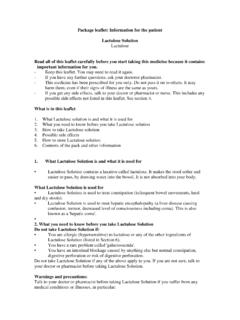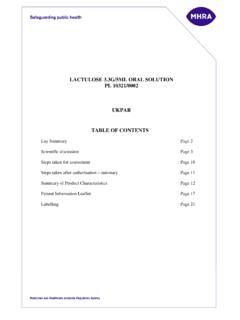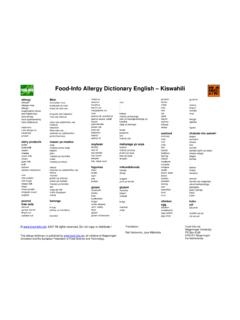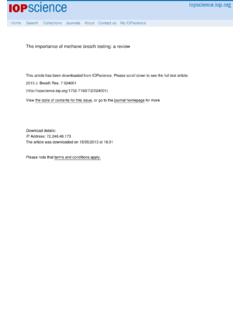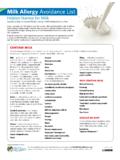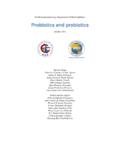Transcription of Hyperglycemia in critical patients: Determinants of ...
1 Hyperglycemia in critical patients : Determinants of insulin Dose cHoicereV assoC Med Bras 2017; 63(5):441-446 441 ORIGINAL ARTICLEH yperglycemia in critical patients : Determinants of insulin dose choicealine KlitzKe Paliosa1, Cassiano teixeira2, regis goulart rosa3, Carine raquel Blatt4*1 Pharmacy Resident, Integrated Multiprofessional Health Residency (REMIS), Irmandade Santa Casa de Miseric rdia de Porto Alegre (ISCMPA) and Universidade Federal de Ci ncias da Sa de de Porto Alegre (UFCSPA), Porto Alegre, RS, Brazil2MD, Intensivist, ISCMPA s Central ICU and Hospital Moinhos de Vento. Adjunct Professor of Internal Medicine, UFSCPA, Porto Alegre, RS, Brazil3MD, Intensivist, Hospital Moinhos de Vento, Porto Alegre, RS, Brazil4 Pharmacist.
2 Adjunct Professor, Department of Pharmaceutical Sciences, UFCSPA. Lecturer of Pharmacy, REMIS, ISCMPA/UFCSPA, Porto Alegre, RS, BrazilsuMMaryStudy conducted at Irmandade Santa Casa de Miseric rdia de Porto Alegre, Porto Alegre, RS, BrazilArticle received: 10/27/2016 Accepted for publication: 11/20/2016*Correspondence: Address: Rua Sarmento Leite, 245 Porto Alegre, RS BrazilPostal code: : To identify factors that can determine the choice of intermittent subcutaneous regular insulin dose in critically ill patients with Hyperglycemia . Method: Cross-sectional study in a general adult ICU with 26 beds, data collected between September and October 2014.
3 The variables analyzed were: sex, age, previous diagnosis of diabetes mellitus, use of corticosteroids, use of lactulose , sepsis, fasting, enteral nutrition, use of dextrose 5% in water, NPH insulin prescription and blood glucose level. patients with one or more episodes of Hyperglycemia (blood glucose greater than 180 mg/dL) were included as a convenience sample, not consecutively. Those with continuous insulin prescription were excluded from : We included 64 records of Hyperglycemia observed in 22 patients who had at least one episode of Hyperglycemia . The median administered subcutaneous regular human insulin was 6 IU and among the factors evaluated only blood glucose levels were associated with the choice of insulin dose : Clinical characteristics such as diet, medications and diagnosis of diabetes mellitus are clearly ignored in the decision-making regarding insulin dose to be administered for glucose control in critically ill patients with.
4 Blood glucose, insulin , intensive care units, Hyperglycemia , diabetes mellitus, Hyperglycemia is elevated blood glucose in the presence of acute illnesses and is frequently observed in patients admitted to an intensive care unit (ICU), with or without a diagnosis of diabetes mellitus (DM).1 A recent study demonstrates that stress Hyperglycemia during ICU stay is associated with increased risk for the development of This phenomenon primarily involves the neuro-immune-endocrine response to stress, with in-creased secretion of cortisol, glucagon and adrenaline, and decreased secretion and action of insulin . Other fac-tors may also be related to high blood glucose, such as exogenous glucose administration, enteral or parenteral nutrition, prolonged bed rest and use of control in the ICU setting began to be im-portant as of 2001, after the publication of a study by Van den Berghe et al.
5 ,4 which demonstrated a 42% reduction in mortality and a 46% reduction in episodes of blood-stream infection in ICU surgical patients when normo-glycemia (80-110 mg/dL) was After these initial data, several prospective randomized studies have dem-onstrated that intensive glycemic control has suggested declines in mortality, multiple organ failure, systemic infections, hospital and ICU stay, and consequent reduc-tion in total hospital Currently, preventing high blood glucose is a recommended and desirable interven-tion. However, the optimal range of glycemic control is References to hypoglycemia in the literature include values between 40 and 80 mg/dL,8-12 while the range of Hyperglycemia is that of 180 to 200 Brazilian Society of Diabetes (SBD) and the guide-lines of the American Diabetes Association/American As-sociation of Clinical Endocrinologists (ADA/AACE) recom-mend, for patients hospitalized in ICU, target blood glucose Paliosa aK et reV assoC Med Bras 2017.
6 63(5):441-446ranges between 140-180 mg/dL and initiation of insulin therapy when blood glucose values are persistently greater than 180 ,13 A US study analyzed blood glucose tests performed at the bedside in ICU and non-ICU wards of 126 hospitals in different regions of the country and showed a prevalence of Hyperglycemia (> 180 mg/dL) of 46% in ICU and outside the ICU. The prevalence of hypoglycemia (< 70 mg/dL), in turn, was in ICU and in non-ICU14 settings. Other authors, in a similar study conducted in 635 hospitals, found a prevalence of hyper-glycemia of and in non-ICU and ICU patients , respectively, whereas the prevalence of hypoglycemia was and in non-ICU and ICU patients , used to control Hyperglycemia is categorized by the Institute for Safe Practice in the Use of Medications as a potentially dangerous drug,16,17 that is, with increased risk of causing significant damage to patients as a result of failure to Therefore, considering the negative clinical outcomes associated with the lack of glycemic con-trol in critically ill patients .
7 The implantation of glycemic control protocols in ICUs is a routine that could contribute to the increased safety of these objective was to identify the Determinants of the choice of intermittent subcutaneous insulin dose used to control Hyperglycemia in critical hyperglycemic design and populationA cross-sectional study was performed in the adult clini-cal and surgical ICU of a large hospital in the southern region of Brazil. This unit has 26 beds and serves patients of the public Unified Health System (SUS, in the Portu-guese acronym), as well as those covered by health insur-ance and private study sample consisted of patients admitted to the ICU from September to October 2014, who were not receiving continuous intravenous insulin .
8 patients hos-pitalized for less than 24 hours or without glycemic monitoring were excluded from the study. VariablesThe following variables were analyzed: age, sex, diagnosis of previous DM, presence or absence of sepsis, results of the capillary blood glucose test, insulin administration, number of episodes of Hyperglycemia (blood glucose above 180 mg/dL) and amounts of International Units (IU) of regular insulin administered. In addition, data were collected on the type of diet the patient was receiving during this period (enteral, par-enteral nutrition or fasting), administration of fast insu-lin (regular) or intermediate-acting insulin (NPH), corti-costeroids, 5% dextrose in water (D5W) or lactulose , and also the number of days of data were collected from the electronic medical chart and the vital signs sheet of each patient and refer to the 24-hour glucose monitoring of patients on a nor-mal routine day.
9 patients were included for convenience and their data collected only once during the study. OutcomeThe dose of regular subcutaneous insulin to be used in episodes of Hyperglycemia was indicated by the medical team on the patient s updated patient chart and admin-istered by the nurses as prescribed. StatisticsQuantitative variables were described as mean and stan-dard deviation. Qualitative variables were described in the form of absolute numbers and percentages. As mul-tiple episodes of Hyperglycemia per patient were evalu-ated, the independence between the episodes can not be assumed. To address this limitation, we chose negative binomial regression as a valid tool for determining the association between the clinical factors of the patient and the choice of intermittent subcutaneous regular insulin dose in a sample of clustered aspectsWe did not need to request informed consent from the patients in our study, since the data collected were ter-tiary and available in their medical charts.
10 The project was approved by the Institution s Ethics Committee un-der the number: on August 4, excluding patients who were receiving continuous insulin , according to institutional protocol, 64 episodes of Hyperglycemia were found in 22 patients . Among pa-tients with episodes of Hyperglycemia , we observed a mean age of years, a higher frequency of male patients ( ), previous diagnosis of DM ( ), absence of sepsis ( ), treatment with D5W ( ), corticoste-roids ( ), lactulose ( ) and enteral diet ( ), hospitalization time in days of + , mean blood glucose levels at 256 + 69 mg/dL, and regular insulin dose per episode of Hyperglycemia of + IU.










